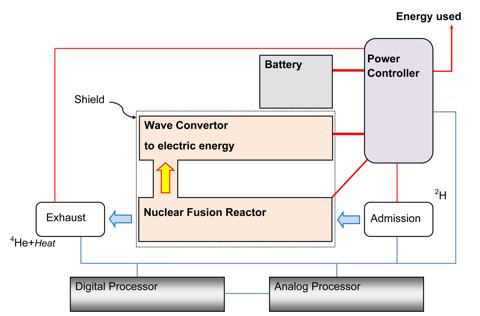[toc]
Objectives of the study.
Although from the theoretical and technology point of view it is a formidable challenge, studies and preliminary analysis that I’ve made and even current scientific achievements make this project possible.
The objective of this project is only to establish the theoretical foundations of a “Reactor-Generator” using fusion technology, with general characteristics that are developed below.
General guidelines for the project.
- The using of a energy production process determined by a controlled reaction of Deuterium-Deuterium fusion to avoid any harmful emissions or any dangerous pollution.

- Transformation of the energy released in the form of electromagnetic radiation by the reaction of Deuterium-Deuterium fusion by direct conversion into electrical energy.
- The usable electrical energy should be between 100 KVA to 1000 KVA of power.
- The size and weight should be equivalent to current internal combustion engines used in transport vehicles.
Schematic diagram of the project.

The controlled nuclear fusion reaction
The controlled nuclear fusion reaction is the process of nuclear fusion reaction where can be controlled independently –between certain limits–, the two most important variables in this process:
- Pressure, that must be submitted to the nuclei for a while to achieve fusion.
- Permanence time, which is the minimum time period that should remain under pressure to achieve fusion.
The regulation of the magnitudes of these two variables during the process of nuclear fusion reaction is very important to obtain a nucleus of Helium 4 from the fusion of two Deuterium nuclei. The magnitudes of these two variables (pressure and permanence time) within which you can obtain the fusion of two Deuterium nuclei to produce Helium 4, I call them as xeimetric magnitudes.
There are three alternatives to change plus or minus xeimetric magnitudes in the process of nuclear fusion reaction and are:
- If the magnitude of the pressure, or permanence time, or both simultaneously, are below the magnitudes xeimetric, the fusion of the nuclei will not be achieved. The nuclei are rejected by nuclear electrostatic forces and it bounce without fusion, as if they were rubber balls.
-
If the variables are within the magnitudes xeimetric, the outcome is the fusion of the Deuterium nuclei with only two products as a result of nuclear fusion process:
- Helium 4.
- Electromagnetic radiation.
- The electromagnetic radiation is caused by the energetic quantum leap of nuclear particles of the Deuterium nuclei to readjust to the new atomic nucleus of Helium 4. The process of fusion within the magnitudes xeimetric I call it as pure fusion.
-
If the magnitude of the pressure is above the magnitude xeimetric, for any magnitude of permanence time, the products of the reaction are always three or four:
- Tritium or Helium 3.
- Neutrons.
- Electromagnetic radiation.
- The process of fusion with this result I call it fusion-fission simultaneously. This is because they always in the process of fusion-fission, one of the two nuclei to fuse, they has been disintegrated by high kinetic energy of the nuclear collision. By the latter cause, I do not consider at these processes, them as pure fusion processes.
The fusion-fission reaction is normally the process that occurs in every fusion reactor which uses a hot plasma to produce fusion Tokamak type, Stellator, etc., the cause lies in the temperature inside the reactor chamber, that is not homogeneous throughout the mass of the plasma reaction. At the core of the plasma there is inevitably a higher temperature than in the periphery of the plasma, determining for the case of the reaction process of fusion of Deuterium, a higher probability on getting Tritium or Helium 3 than obtaining Helium 4.
The most trouble aspects that make it impossible to think of low-power reactors, using the principle of hot plasma to produce the fusion reaction are two:
- Impossibility to achieve a uniform temperature within the entire plasma volume.
- Impossibility to control the permanence time during the reaction.
For this reason, every hot plasma reactor, the energy produced by the fusion-fission reaction of the ionized atoms within the plasma, only can be used by processes of convection temperature, such as if it were a steam boiler. This type of process is absolutely valid for fusion reactors of enormous energy production capacity –10 to 100 MVA or more–, such as the Tokamak reactor under construction in the ITER. This development is consistent with the current technology and the urgency of putting into production fusion plants after to generate electricity, replacing the current nuclear fission plants and conventional plants. The urgency is due to climate change that we are coming and we are already suffering.
Xeimetric magnitudes of the reaction D+D
Necessarily to know the xeimetric magnitudes of the fusion reaction D+D (Deuterium-Deuterium), we must determine with maximum precision the dimensional, energetic and dynamic properties of the nuclei of deuterium and helium 4.
To know the properties of the atomic nuclei of deuterium and helium 4, I will start from the following published studies: “QEDa Theory: The atom and their nucleus, 10/14/2005, in Spanish (Teoría QEDa – El átomo y su núcleo)”, “The Hydrogen family – Stability and Gyromagnetic ratios, 2/6/2007”, “The Helium family – Stability and Gyromagnetic ratios, 6/10/2007” and “Speed of atomic particles and physical constants, 02/28/2008”.
This new study is titled: “The controlled nuclear fusion reaction of deuterium-deuterium – Xeimetric magnitudes” and it will be published in the future.